Leading Change: Impact on Strategy, Behavior, and Minimization
VerifiedAdded on 2020/06/04
|13
|4256
|46
Report
AI Summary
This report delves into the realm of change management, examining its impact on organizational strategy and operations. It begins by comparing two organizations, M&S and H&M, analyzing how they adapt to internal and external changes. The report evaluates the drivers of change, including political, economic, socio-cultural, technological, and legal factors, and assesses their effects on leadership, team dynamics, and individual behavior. Furthermore, it explores strategies to minimize the negative impacts of change on organizational behavior, such as utilizing the Burke-Litwin model. The report also addresses barriers to change, their influence on decision-making, and different leadership approaches in managing change, providing a comprehensive overview of the challenges and opportunities associated with leading change effectively within an organization.
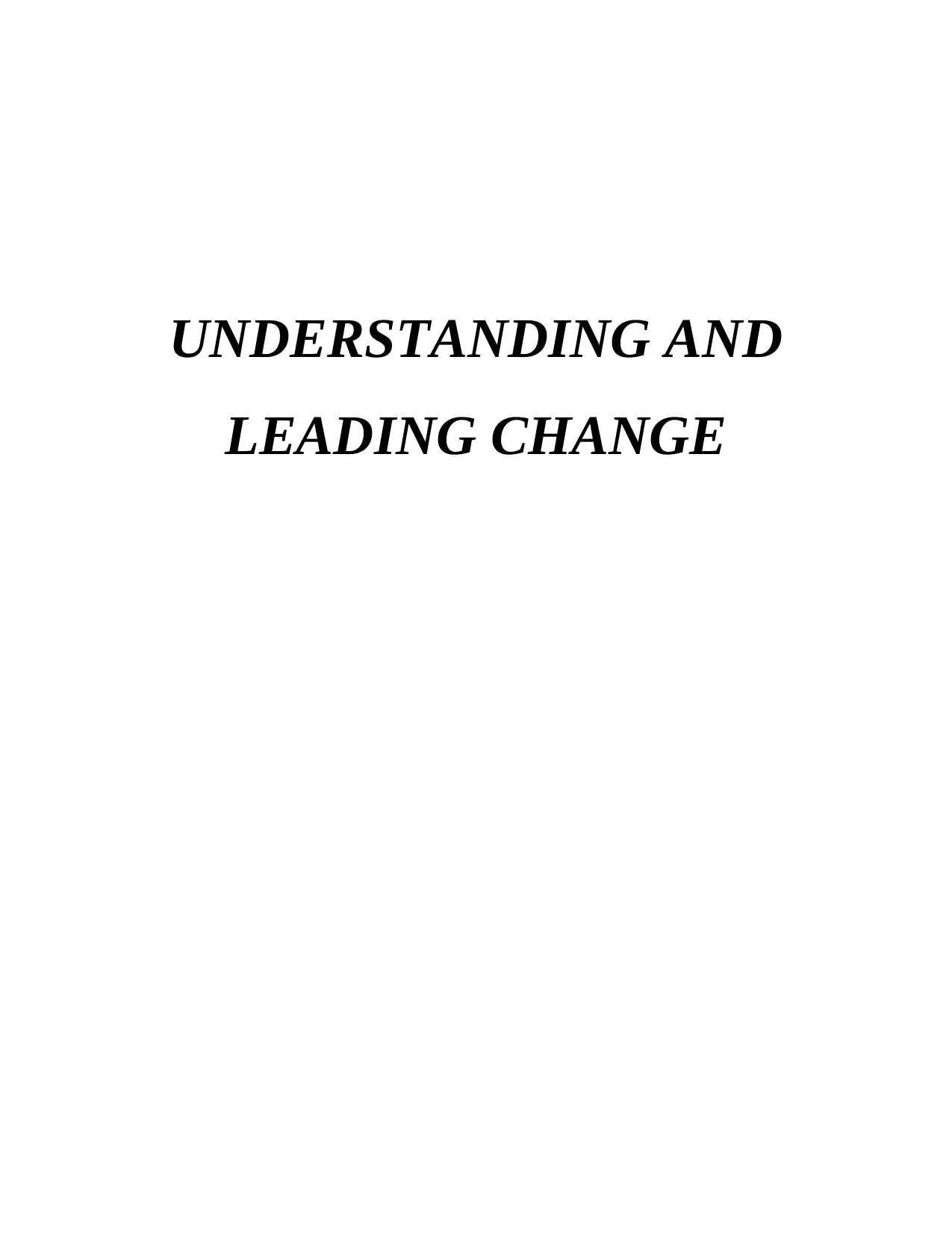
UNDERSTANDING AND
LEADING CHANGE
LEADING CHANGE
Paraphrase This Document
Need a fresh take? Get an instant paraphrase of this document with our AI Paraphraser
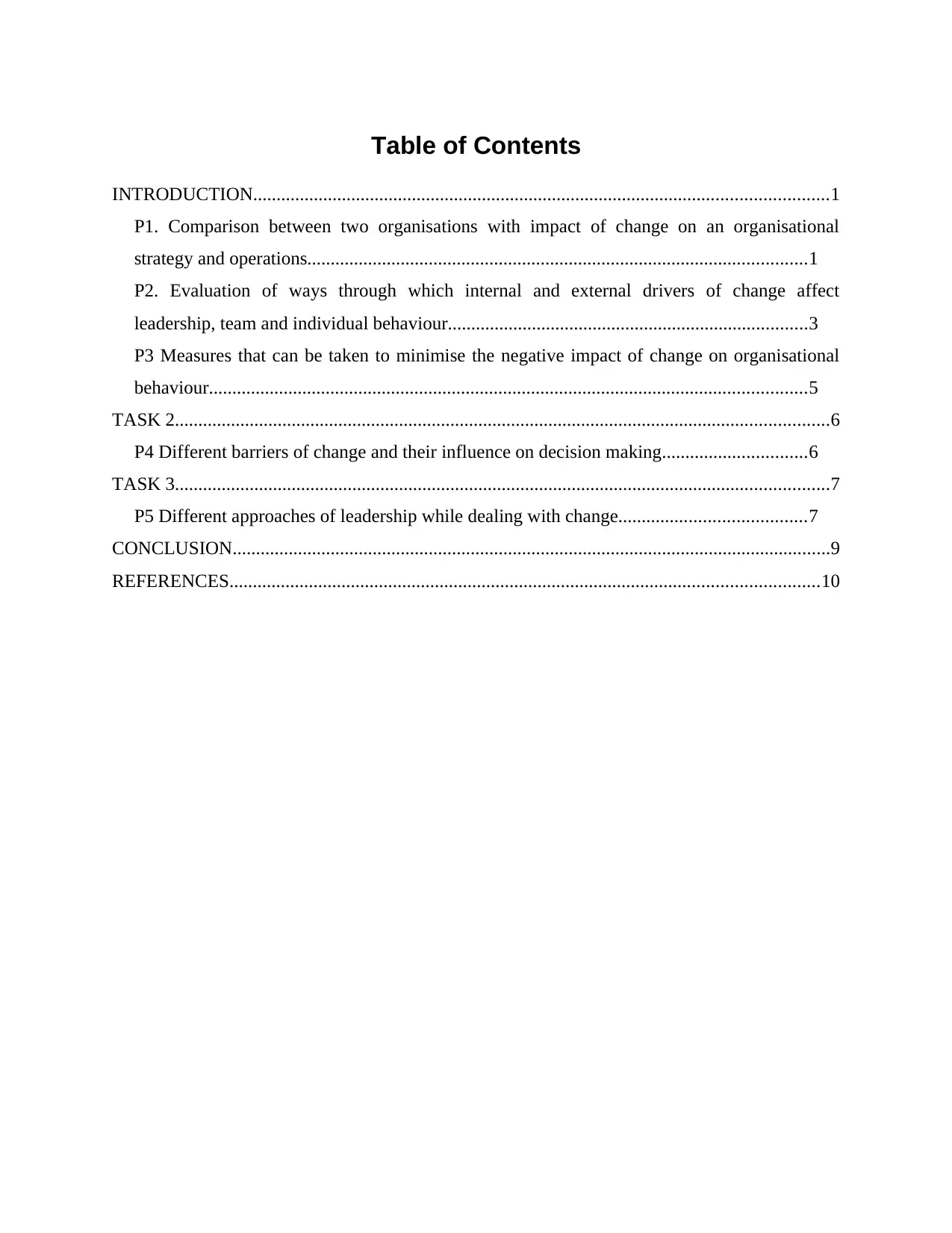
Table of Contents
INTRODUCTION...........................................................................................................................1
P1. Comparison between two organisations with impact of change on an organisational
strategy and operations...........................................................................................................1
P2. Evaluation of ways through which internal and external drivers of change affect
leadership, team and individual behaviour.............................................................................3
P3 Measures that can be taken to minimise the negative impact of change on organisational
behaviour................................................................................................................................5
TASK 2............................................................................................................................................6
P4 Different barriers of change and their influence on decision making...............................6
TASK 3............................................................................................................................................7
P5 Different approaches of leadership while dealing with change........................................7
CONCLUSION................................................................................................................................9
REFERENCES..............................................................................................................................10
INTRODUCTION...........................................................................................................................1
P1. Comparison between two organisations with impact of change on an organisational
strategy and operations...........................................................................................................1
P2. Evaluation of ways through which internal and external drivers of change affect
leadership, team and individual behaviour.............................................................................3
P3 Measures that can be taken to minimise the negative impact of change on organisational
behaviour................................................................................................................................5
TASK 2............................................................................................................................................6
P4 Different barriers of change and their influence on decision making...............................6
TASK 3............................................................................................................................................7
P5 Different approaches of leadership while dealing with change........................................7
CONCLUSION................................................................................................................................9
REFERENCES..............................................................................................................................10
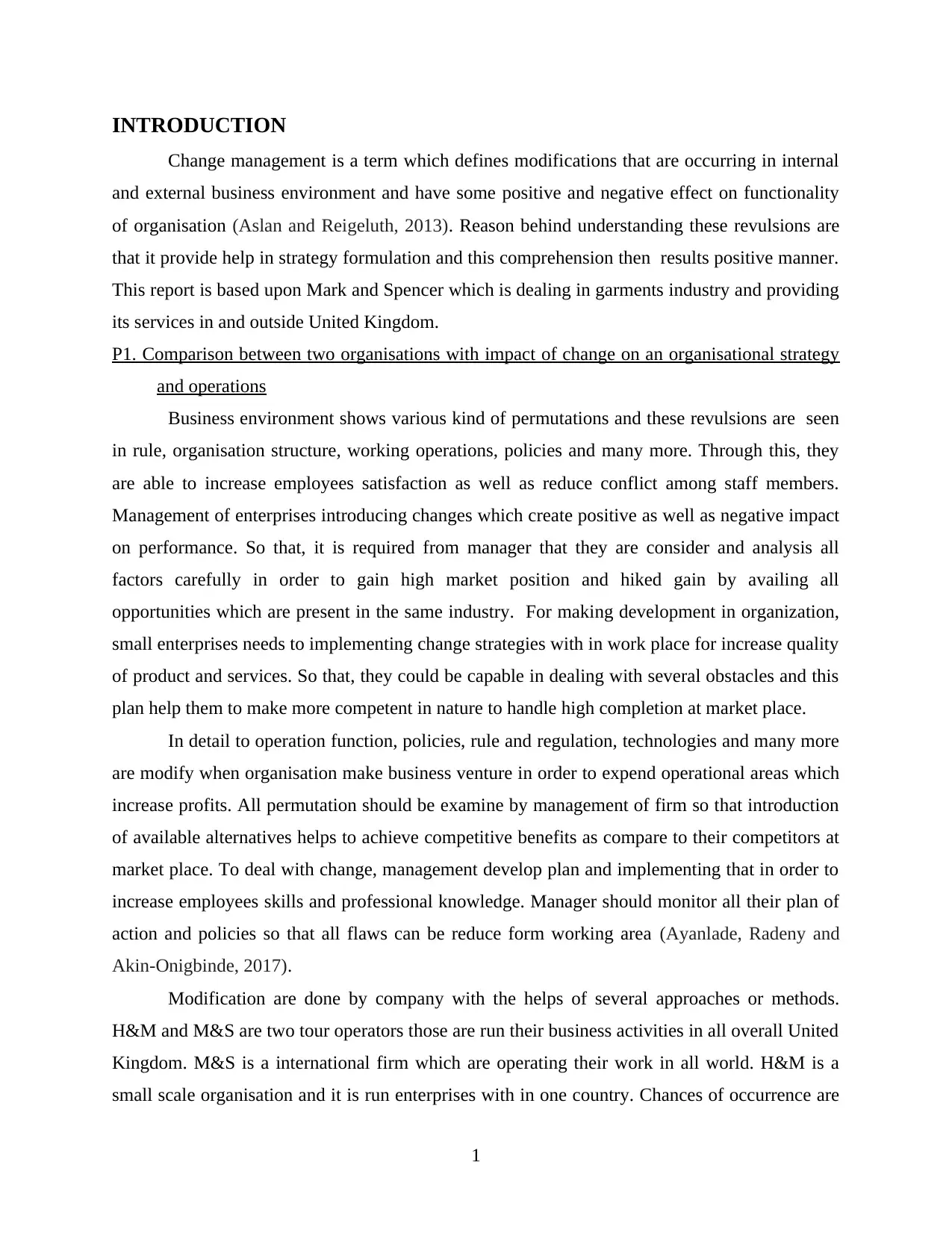
INTRODUCTION
Change management is a term which defines modifications that are occurring in internal
and external business environment and have some positive and negative effect on functionality
of organisation (Aslan and Reigeluth, 2013). Reason behind understanding these revulsions are
that it provide help in strategy formulation and this comprehension then results positive manner.
This report is based upon Mark and Spencer which is dealing in garments industry and providing
its services in and outside United Kingdom.
P1. Comparison between two organisations with impact of change on an organisational strategy
and operations
Business environment shows various kind of permutations and these revulsions are seen
in rule, organisation structure, working operations, policies and many more. Through this, they
are able to increase employees satisfaction as well as reduce conflict among staff members.
Management of enterprises introducing changes which create positive as well as negative impact
on performance. So that, it is required from manager that they are consider and analysis all
factors carefully in order to gain high market position and hiked gain by availing all
opportunities which are present in the same industry. For making development in organization,
small enterprises needs to implementing change strategies with in work place for increase quality
of product and services. So that, they could be capable in dealing with several obstacles and this
plan help them to make more competent in nature to handle high completion at market place.
In detail to operation function, policies, rule and regulation, technologies and many more
are modify when organisation make business venture in order to expend operational areas which
increase profits. All permutation should be examine by management of firm so that introduction
of available alternatives helps to achieve competitive benefits as compare to their competitors at
market place. To deal with change, management develop plan and implementing that in order to
increase employees skills and professional knowledge. Manager should monitor all their plan of
action and policies so that all flaws can be reduce form working area (Ayanlade, Radeny and
Akin-Onigbinde, 2017).
Modification are done by company with the helps of several approaches or methods.
H&M and M&S are two tour operators those are run their business activities in all overall United
Kingdom. M&S is a international firm which are operating their work in all world. H&M is a
small scale organisation and it is run enterprises with in one country. Chances of occurrence are
1
Change management is a term which defines modifications that are occurring in internal
and external business environment and have some positive and negative effect on functionality
of organisation (Aslan and Reigeluth, 2013). Reason behind understanding these revulsions are
that it provide help in strategy formulation and this comprehension then results positive manner.
This report is based upon Mark and Spencer which is dealing in garments industry and providing
its services in and outside United Kingdom.
P1. Comparison between two organisations with impact of change on an organisational strategy
and operations
Business environment shows various kind of permutations and these revulsions are seen
in rule, organisation structure, working operations, policies and many more. Through this, they
are able to increase employees satisfaction as well as reduce conflict among staff members.
Management of enterprises introducing changes which create positive as well as negative impact
on performance. So that, it is required from manager that they are consider and analysis all
factors carefully in order to gain high market position and hiked gain by availing all
opportunities which are present in the same industry. For making development in organization,
small enterprises needs to implementing change strategies with in work place for increase quality
of product and services. So that, they could be capable in dealing with several obstacles and this
plan help them to make more competent in nature to handle high completion at market place.
In detail to operation function, policies, rule and regulation, technologies and many more
are modify when organisation make business venture in order to expend operational areas which
increase profits. All permutation should be examine by management of firm so that introduction
of available alternatives helps to achieve competitive benefits as compare to their competitors at
market place. To deal with change, management develop plan and implementing that in order to
increase employees skills and professional knowledge. Manager should monitor all their plan of
action and policies so that all flaws can be reduce form working area (Ayanlade, Radeny and
Akin-Onigbinde, 2017).
Modification are done by company with the helps of several approaches or methods.
H&M and M&S are two tour operators those are run their business activities in all overall United
Kingdom. M&S is a international firm which are operating their work in all world. H&M is a
small scale organisation and it is run enterprises with in one country. Chances of occurrence are
1
⊘ This is a preview!⊘
Do you want full access?
Subscribe today to unlock all pages.

Trusted by 1+ million students worldwide
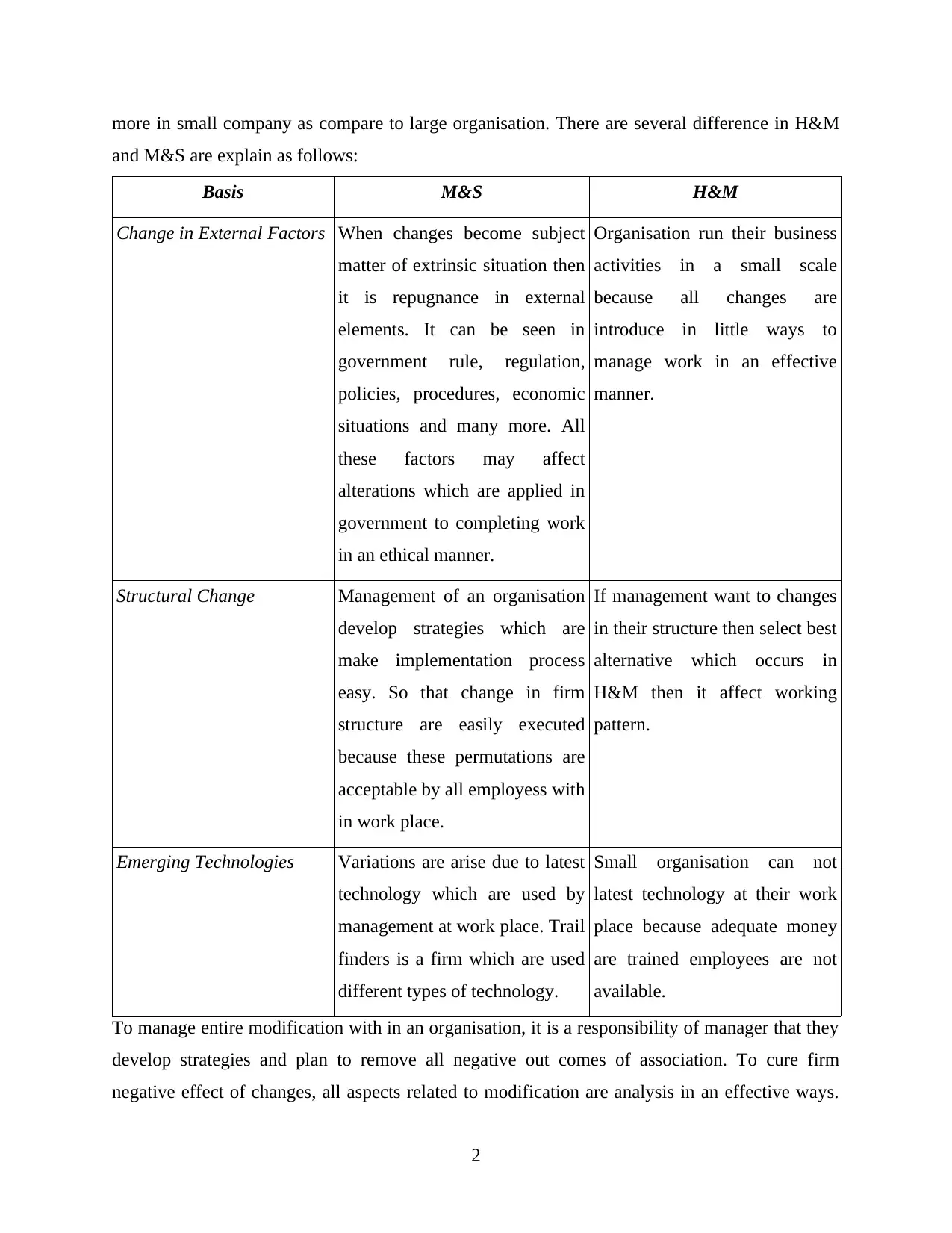
more in small company as compare to large organisation. There are several difference in H&M
and M&S are explain as follows:
Basis M&S H&M
Change in External Factors When changes become subject
matter of extrinsic situation then
it is repugnance in external
elements. It can be seen in
government rule, regulation,
policies, procedures, economic
situations and many more. All
these factors may affect
alterations which are applied in
government to completing work
in an ethical manner.
Organisation run their business
activities in a small scale
because all changes are
introduce in little ways to
manage work in an effective
manner.
Structural Change Management of an organisation
develop strategies which are
make implementation process
easy. So that change in firm
structure are easily executed
because these permutations are
acceptable by all employess with
in work place.
If management want to changes
in their structure then select best
alternative which occurs in
H&M then it affect working
pattern.
Emerging Technologies Variations are arise due to latest
technology which are used by
management at work place. Trail
finders is a firm which are used
different types of technology.
Small organisation can not
latest technology at their work
place because adequate money
are trained employees are not
available.
To manage entire modification with in an organisation, it is a responsibility of manager that they
develop strategies and plan to remove all negative out comes of association. To cure firm
negative effect of changes, all aspects related to modification are analysis in an effective ways.
2
and M&S are explain as follows:
Basis M&S H&M
Change in External Factors When changes become subject
matter of extrinsic situation then
it is repugnance in external
elements. It can be seen in
government rule, regulation,
policies, procedures, economic
situations and many more. All
these factors may affect
alterations which are applied in
government to completing work
in an ethical manner.
Organisation run their business
activities in a small scale
because all changes are
introduce in little ways to
manage work in an effective
manner.
Structural Change Management of an organisation
develop strategies which are
make implementation process
easy. So that change in firm
structure are easily executed
because these permutations are
acceptable by all employess with
in work place.
If management want to changes
in their structure then select best
alternative which occurs in
H&M then it affect working
pattern.
Emerging Technologies Variations are arise due to latest
technology which are used by
management at work place. Trail
finders is a firm which are used
different types of technology.
Small organisation can not
latest technology at their work
place because adequate money
are trained employees are not
available.
To manage entire modification with in an organisation, it is a responsibility of manager that they
develop strategies and plan to remove all negative out comes of association. To cure firm
negative effect of changes, all aspects related to modification are analysis in an effective ways.
2
Paraphrase This Document
Need a fresh take? Get an instant paraphrase of this document with our AI Paraphraser
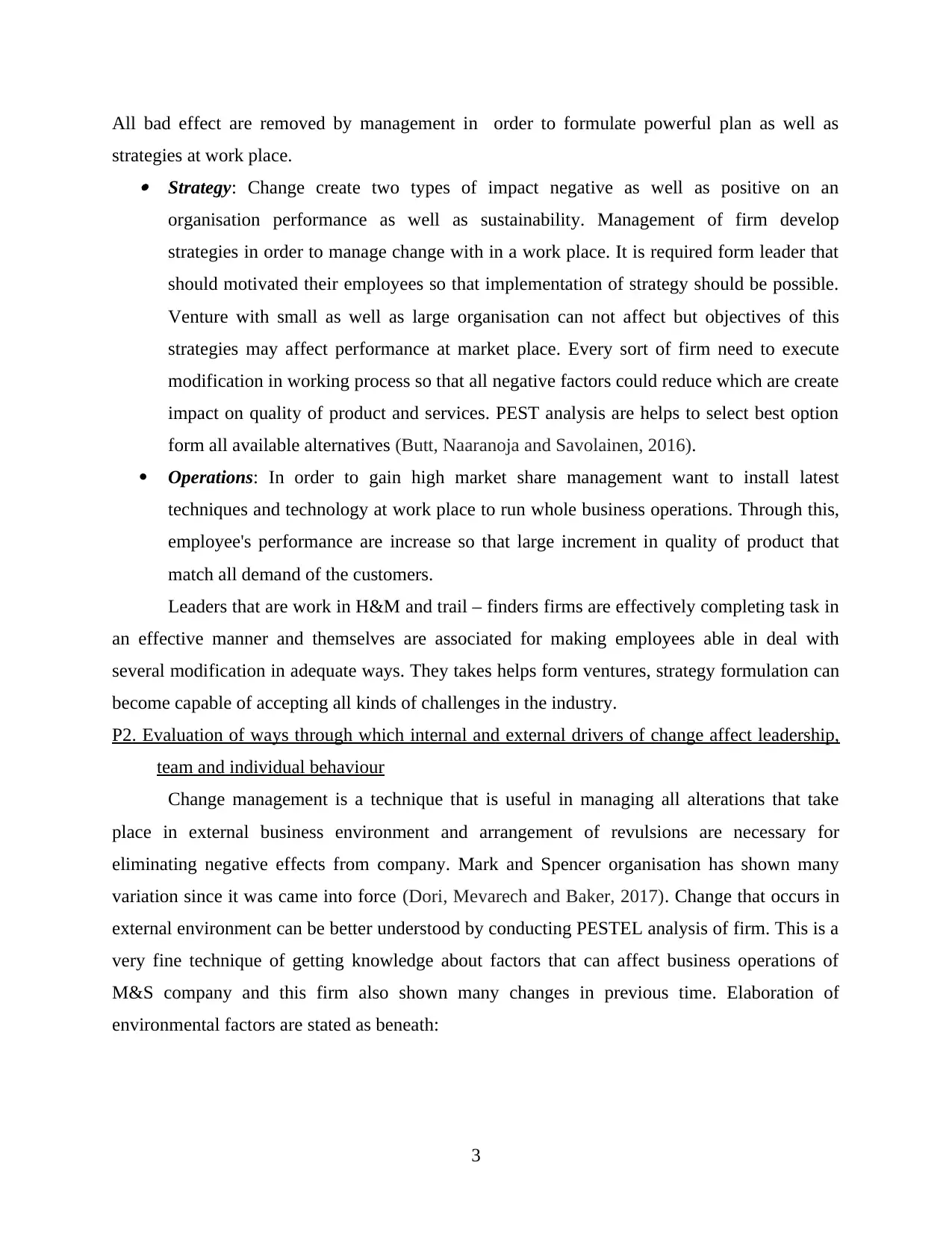
All bad effect are removed by management in order to formulate powerful plan as well as
strategies at work place. Strategy: Change create two types of impact negative as well as positive on an
organisation performance as well as sustainability. Management of firm develop
strategies in order to manage change with in a work place. It is required form leader that
should motivated their employees so that implementation of strategy should be possible.
Venture with small as well as large organisation can not affect but objectives of this
strategies may affect performance at market place. Every sort of firm need to execute
modification in working process so that all negative factors could reduce which are create
impact on quality of product and services. PEST analysis are helps to select best option
form all available alternatives (Butt, Naaranoja and Savolainen, 2016).
Operations: In order to gain high market share management want to install latest
techniques and technology at work place to run whole business operations. Through this,
employee's performance are increase so that large increment in quality of product that
match all demand of the customers.
Leaders that are work in H&M and trail – finders firms are effectively completing task in
an effective manner and themselves are associated for making employees able in deal with
several modification in adequate ways. They takes helps form ventures, strategy formulation can
become capable of accepting all kinds of challenges in the industry.
P2. Evaluation of ways through which internal and external drivers of change affect leadership,
team and individual behaviour
Change management is a technique that is useful in managing all alterations that take
place in external business environment and arrangement of revulsions are necessary for
eliminating negative effects from company. Mark and Spencer organisation has shown many
variation since it was came into force (Dori, Mevarech and Baker, 2017). Change that occurs in
external environment can be better understood by conducting PESTEL analysis of firm. This is a
very fine technique of getting knowledge about factors that can affect business operations of
M&S company and this firm also shown many changes in previous time. Elaboration of
environmental factors are stated as beneath:
3
strategies at work place. Strategy: Change create two types of impact negative as well as positive on an
organisation performance as well as sustainability. Management of firm develop
strategies in order to manage change with in a work place. It is required form leader that
should motivated their employees so that implementation of strategy should be possible.
Venture with small as well as large organisation can not affect but objectives of this
strategies may affect performance at market place. Every sort of firm need to execute
modification in working process so that all negative factors could reduce which are create
impact on quality of product and services. PEST analysis are helps to select best option
form all available alternatives (Butt, Naaranoja and Savolainen, 2016).
Operations: In order to gain high market share management want to install latest
techniques and technology at work place to run whole business operations. Through this,
employee's performance are increase so that large increment in quality of product that
match all demand of the customers.
Leaders that are work in H&M and trail – finders firms are effectively completing task in
an effective manner and themselves are associated for making employees able in deal with
several modification in adequate ways. They takes helps form ventures, strategy formulation can
become capable of accepting all kinds of challenges in the industry.
P2. Evaluation of ways through which internal and external drivers of change affect leadership,
team and individual behaviour
Change management is a technique that is useful in managing all alterations that take
place in external business environment and arrangement of revulsions are necessary for
eliminating negative effects from company. Mark and Spencer organisation has shown many
variation since it was came into force (Dori, Mevarech and Baker, 2017). Change that occurs in
external environment can be better understood by conducting PESTEL analysis of firm. This is a
very fine technique of getting knowledge about factors that can affect business operations of
M&S company and this firm also shown many changes in previous time. Elaboration of
environmental factors are stated as beneath:
3
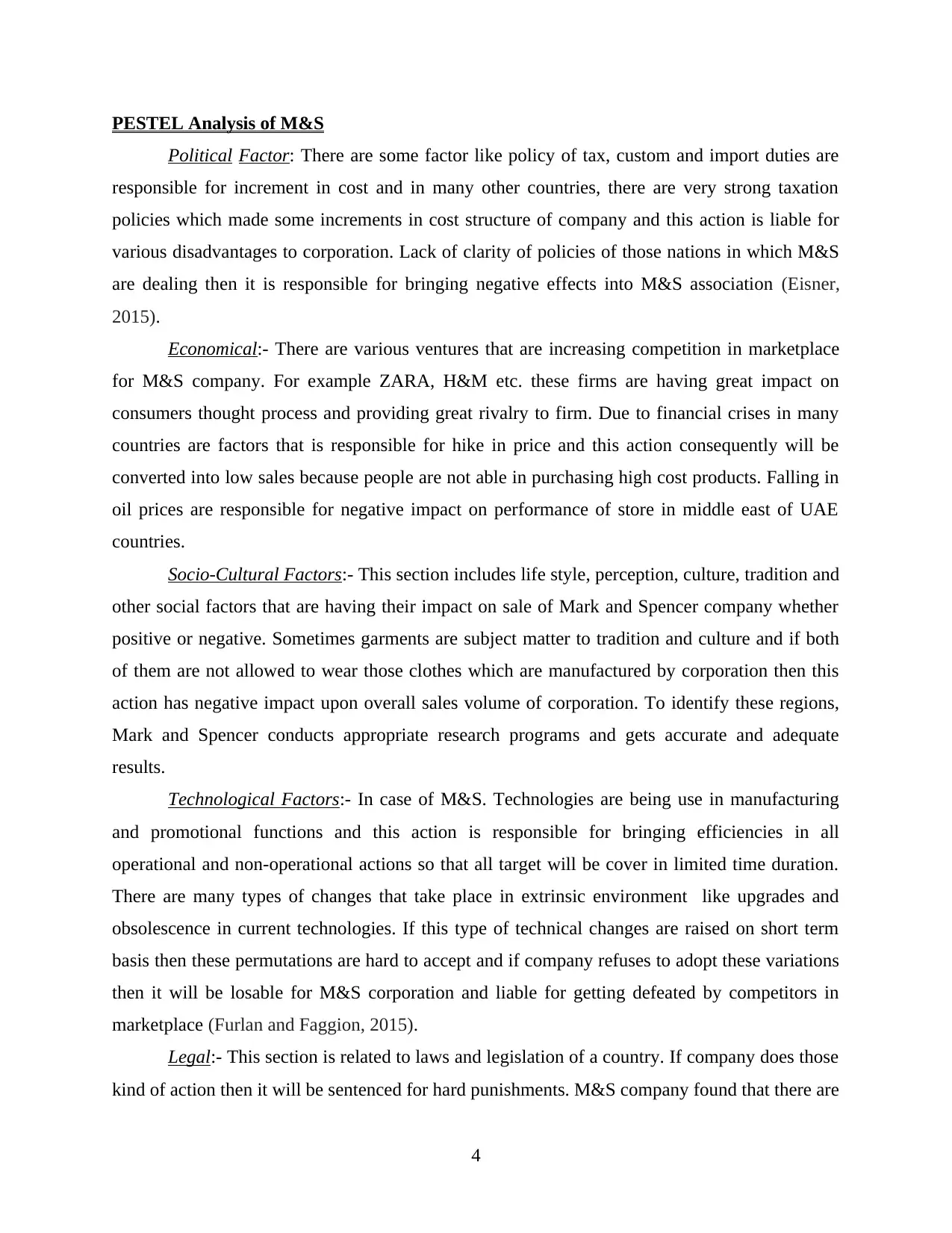
PESTEL Analysis of M&S
Political Factor: There are some factor like policy of tax, custom and import duties are
responsible for increment in cost and in many other countries, there are very strong taxation
policies which made some increments in cost structure of company and this action is liable for
various disadvantages to corporation. Lack of clarity of policies of those nations in which M&S
are dealing then it is responsible for bringing negative effects into M&S association (Eisner,
2015).
Economical:- There are various ventures that are increasing competition in marketplace
for M&S company. For example ZARA, H&M etc. these firms are having great impact on
consumers thought process and providing great rivalry to firm. Due to financial crises in many
countries are factors that is responsible for hike in price and this action consequently will be
converted into low sales because people are not able in purchasing high cost products. Falling in
oil prices are responsible for negative impact on performance of store in middle east of UAE
countries.
Socio-Cultural Factors:- This section includes life style, perception, culture, tradition and
other social factors that are having their impact on sale of Mark and Spencer company whether
positive or negative. Sometimes garments are subject matter to tradition and culture and if both
of them are not allowed to wear those clothes which are manufactured by corporation then this
action has negative impact upon overall sales volume of corporation. To identify these regions,
Mark and Spencer conducts appropriate research programs and gets accurate and adequate
results.
Technological Factors:- In case of M&S. Technologies are being use in manufacturing
and promotional functions and this action is responsible for bringing efficiencies in all
operational and non-operational actions so that all target will be cover in limited time duration.
There are many types of changes that take place in extrinsic environment like upgrades and
obsolescence in current technologies. If this type of technical changes are raised on short term
basis then these permutations are hard to accept and if company refuses to adopt these variations
then it will be losable for M&S corporation and liable for getting defeated by competitors in
marketplace (Furlan and Faggion, 2015).
Legal:- This section is related to laws and legislation of a country. If company does those
kind of action then it will be sentenced for hard punishments. M&S company found that there are
4
Political Factor: There are some factor like policy of tax, custom and import duties are
responsible for increment in cost and in many other countries, there are very strong taxation
policies which made some increments in cost structure of company and this action is liable for
various disadvantages to corporation. Lack of clarity of policies of those nations in which M&S
are dealing then it is responsible for bringing negative effects into M&S association (Eisner,
2015).
Economical:- There are various ventures that are increasing competition in marketplace
for M&S company. For example ZARA, H&M etc. these firms are having great impact on
consumers thought process and providing great rivalry to firm. Due to financial crises in many
countries are factors that is responsible for hike in price and this action consequently will be
converted into low sales because people are not able in purchasing high cost products. Falling in
oil prices are responsible for negative impact on performance of store in middle east of UAE
countries.
Socio-Cultural Factors:- This section includes life style, perception, culture, tradition and
other social factors that are having their impact on sale of Mark and Spencer company whether
positive or negative. Sometimes garments are subject matter to tradition and culture and if both
of them are not allowed to wear those clothes which are manufactured by corporation then this
action has negative impact upon overall sales volume of corporation. To identify these regions,
Mark and Spencer conducts appropriate research programs and gets accurate and adequate
results.
Technological Factors:- In case of M&S. Technologies are being use in manufacturing
and promotional functions and this action is responsible for bringing efficiencies in all
operational and non-operational actions so that all target will be cover in limited time duration.
There are many types of changes that take place in extrinsic environment like upgrades and
obsolescence in current technologies. If this type of technical changes are raised on short term
basis then these permutations are hard to accept and if company refuses to adopt these variations
then it will be losable for M&S corporation and liable for getting defeated by competitors in
marketplace (Furlan and Faggion, 2015).
Legal:- This section is related to laws and legislation of a country. If company does those
kind of action then it will be sentenced for hard punishments. M&S company found that there are
4
⊘ This is a preview!⊘
Do you want full access?
Subscribe today to unlock all pages.

Trusted by 1+ million students worldwide
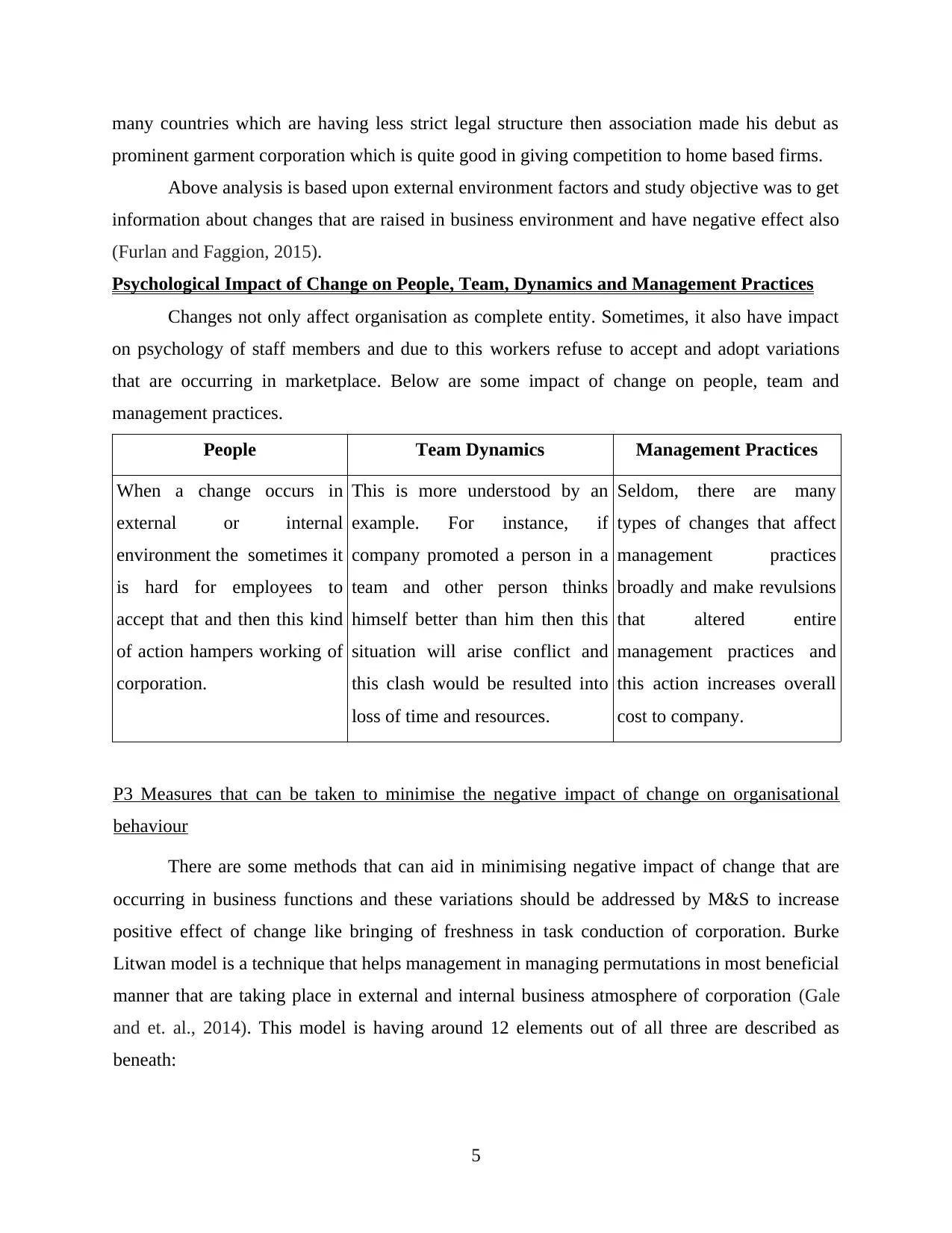
many countries which are having less strict legal structure then association made his debut as
prominent garment corporation which is quite good in giving competition to home based firms.
Above analysis is based upon external environment factors and study objective was to get
information about changes that are raised in business environment and have negative effect also
(Furlan and Faggion, 2015).
Psychological Impact of Change on People, Team, Dynamics and Management Practices
Changes not only affect organisation as complete entity. Sometimes, it also have impact
on psychology of staff members and due to this workers refuse to accept and adopt variations
that are occurring in marketplace. Below are some impact of change on people, team and
management practices.
People Team Dynamics Management Practices
When a change occurs in
external or internal
environment the sometimes it
is hard for employees to
accept that and then this kind
of action hampers working of
corporation.
This is more understood by an
example. For instance, if
company promoted a person in a
team and other person thinks
himself better than him then this
situation will arise conflict and
this clash would be resulted into
loss of time and resources.
Seldom, there are many
types of changes that affect
management practices
broadly and make revulsions
that altered entire
management practices and
this action increases overall
cost to company.
P3 Measures that can be taken to minimise the negative impact of change on organisational
behaviour
There are some methods that can aid in minimising negative impact of change that are
occurring in business functions and these variations should be addressed by M&S to increase
positive effect of change like bringing of freshness in task conduction of corporation. Burke
Litwan model is a technique that helps management in managing permutations in most beneficial
manner that are taking place in external and internal business atmosphere of corporation (Gale
and et. al., 2014). This model is having around 12 elements out of all three are described as
beneath:
5
prominent garment corporation which is quite good in giving competition to home based firms.
Above analysis is based upon external environment factors and study objective was to get
information about changes that are raised in business environment and have negative effect also
(Furlan and Faggion, 2015).
Psychological Impact of Change on People, Team, Dynamics and Management Practices
Changes not only affect organisation as complete entity. Sometimes, it also have impact
on psychology of staff members and due to this workers refuse to accept and adopt variations
that are occurring in marketplace. Below are some impact of change on people, team and
management practices.
People Team Dynamics Management Practices
When a change occurs in
external or internal
environment the sometimes it
is hard for employees to
accept that and then this kind
of action hampers working of
corporation.
This is more understood by an
example. For instance, if
company promoted a person in a
team and other person thinks
himself better than him then this
situation will arise conflict and
this clash would be resulted into
loss of time and resources.
Seldom, there are many
types of changes that affect
management practices
broadly and make revulsions
that altered entire
management practices and
this action increases overall
cost to company.
P3 Measures that can be taken to minimise the negative impact of change on organisational
behaviour
There are some methods that can aid in minimising negative impact of change that are
occurring in business functions and these variations should be addressed by M&S to increase
positive effect of change like bringing of freshness in task conduction of corporation. Burke
Litwan model is a technique that helps management in managing permutations in most beneficial
manner that are taking place in external and internal business atmosphere of corporation (Gale
and et. al., 2014). This model is having around 12 elements out of all three are described as
beneath:
5
Paraphrase This Document
Need a fresh take? Get an instant paraphrase of this document with our AI Paraphraser
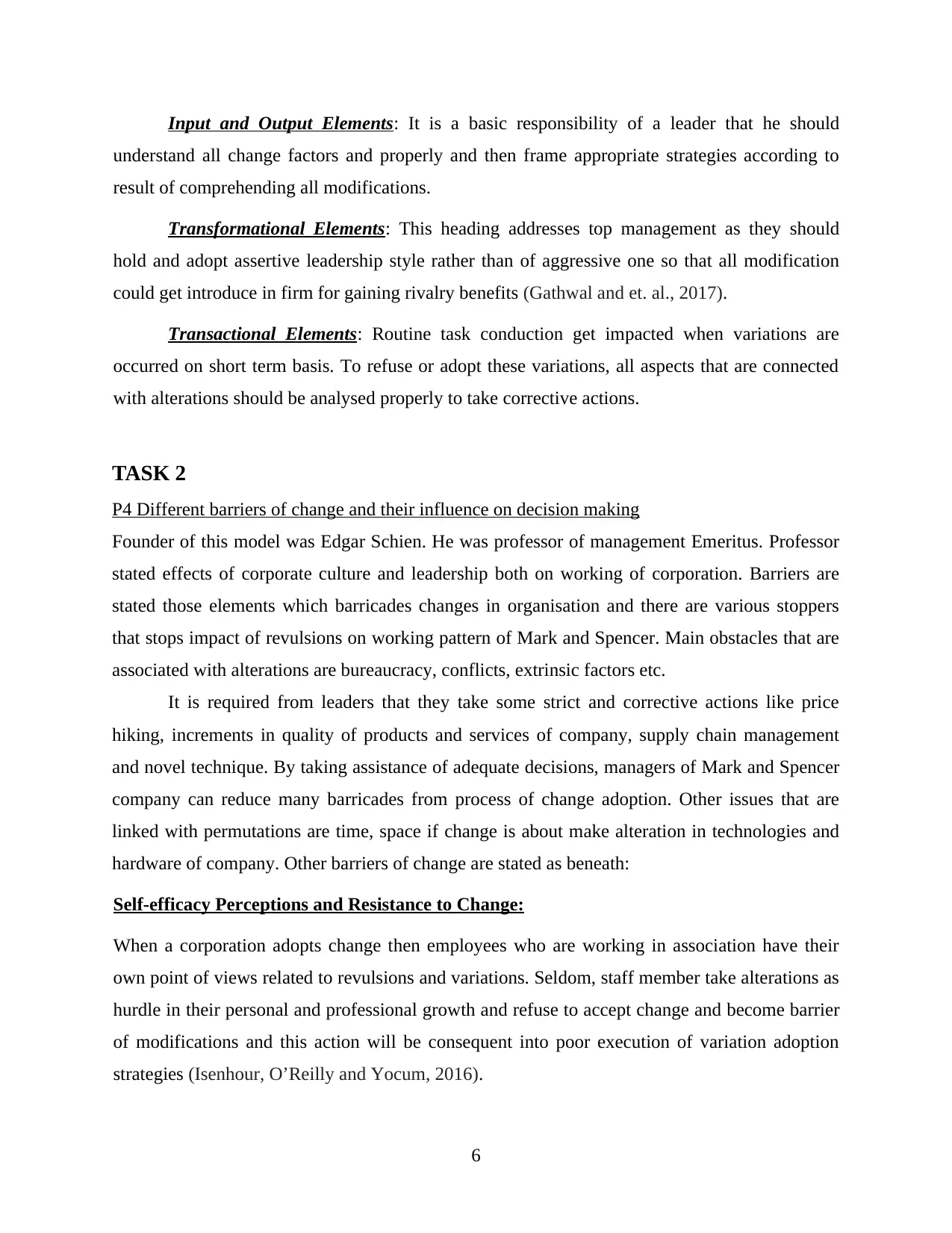
Input and Output Elements: It is a basic responsibility of a leader that he should
understand all change factors and properly and then frame appropriate strategies according to
result of comprehending all modifications.
Transformational Elements: This heading addresses top management as they should
hold and adopt assertive leadership style rather than of aggressive one so that all modification
could get introduce in firm for gaining rivalry benefits (Gathwal and et. al., 2017).
Transactional Elements: Routine task conduction get impacted when variations are
occurred on short term basis. To refuse or adopt these variations, all aspects that are connected
with alterations should be analysed properly to take corrective actions.
TASK 2
P4 Different barriers of change and their influence on decision making
Founder of this model was Edgar Schien. He was professor of management Emeritus. Professor
stated effects of corporate culture and leadership both on working of corporation. Barriers are
stated those elements which barricades changes in organisation and there are various stoppers
that stops impact of revulsions on working pattern of Mark and Spencer. Main obstacles that are
associated with alterations are bureaucracy, conflicts, extrinsic factors etc.
It is required from leaders that they take some strict and corrective actions like price
hiking, increments in quality of products and services of company, supply chain management
and novel technique. By taking assistance of adequate decisions, managers of Mark and Spencer
company can reduce many barricades from process of change adoption. Other issues that are
linked with permutations are time, space if change is about make alteration in technologies and
hardware of company. Other barriers of change are stated as beneath:
Self-efficacy Perceptions and Resistance to Change:
When a corporation adopts change then employees who are working in association have their
own point of views related to revulsions and variations. Seldom, staff member take alterations as
hurdle in their personal and professional growth and refuse to accept change and become barrier
of modifications and this action will be consequent into poor execution of variation adoption
strategies (Isenhour, O’Reilly and Yocum, 2016).
6
understand all change factors and properly and then frame appropriate strategies according to
result of comprehending all modifications.
Transformational Elements: This heading addresses top management as they should
hold and adopt assertive leadership style rather than of aggressive one so that all modification
could get introduce in firm for gaining rivalry benefits (Gathwal and et. al., 2017).
Transactional Elements: Routine task conduction get impacted when variations are
occurred on short term basis. To refuse or adopt these variations, all aspects that are connected
with alterations should be analysed properly to take corrective actions.
TASK 2
P4 Different barriers of change and their influence on decision making
Founder of this model was Edgar Schien. He was professor of management Emeritus. Professor
stated effects of corporate culture and leadership both on working of corporation. Barriers are
stated those elements which barricades changes in organisation and there are various stoppers
that stops impact of revulsions on working pattern of Mark and Spencer. Main obstacles that are
associated with alterations are bureaucracy, conflicts, extrinsic factors etc.
It is required from leaders that they take some strict and corrective actions like price
hiking, increments in quality of products and services of company, supply chain management
and novel technique. By taking assistance of adequate decisions, managers of Mark and Spencer
company can reduce many barricades from process of change adoption. Other issues that are
linked with permutations are time, space if change is about make alteration in technologies and
hardware of company. Other barriers of change are stated as beneath:
Self-efficacy Perceptions and Resistance to Change:
When a corporation adopts change then employees who are working in association have their
own point of views related to revulsions and variations. Seldom, staff member take alterations as
hurdle in their personal and professional growth and refuse to accept change and become barrier
of modifications and this action will be consequent into poor execution of variation adoption
strategies (Isenhour, O’Reilly and Yocum, 2016).
6
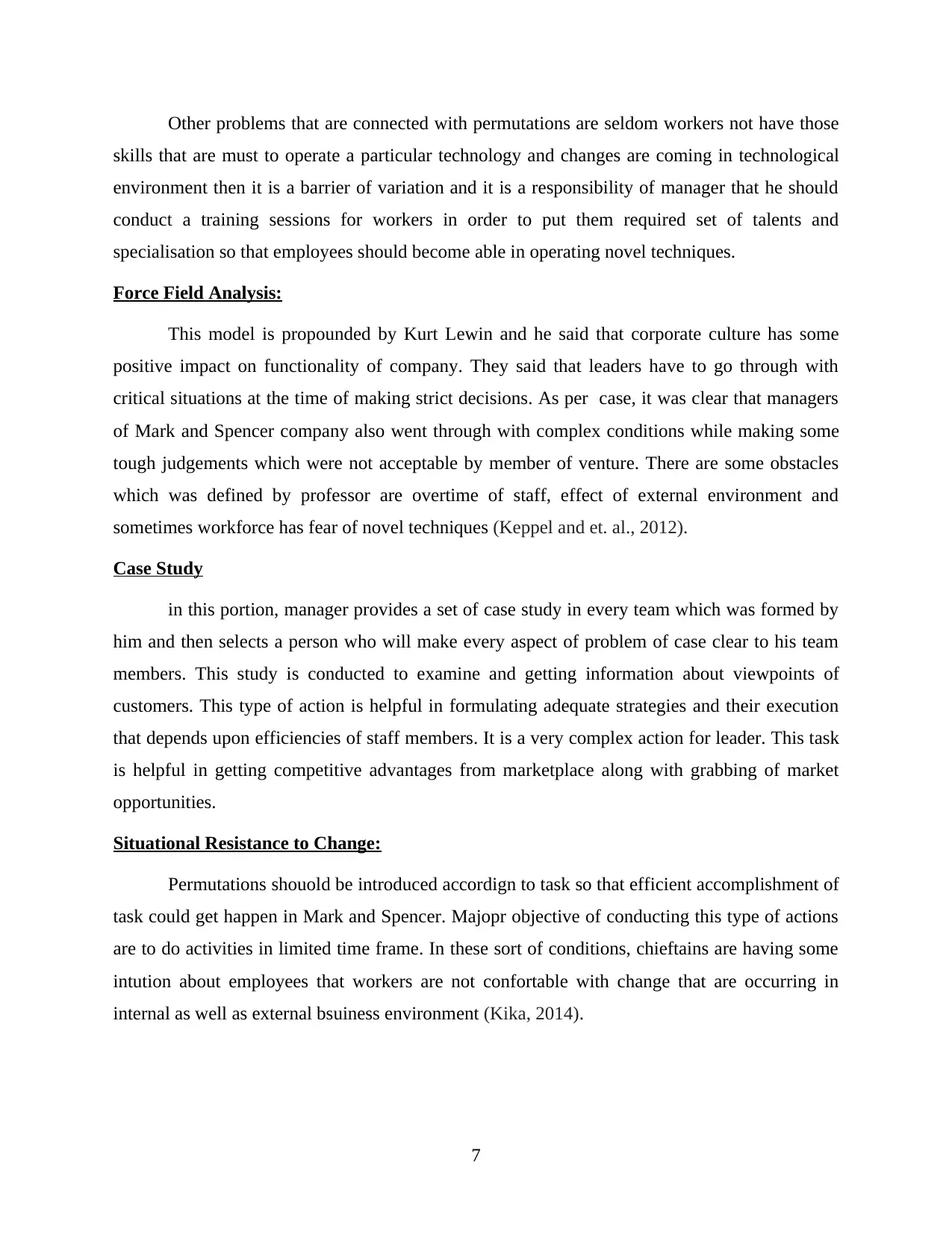
Other problems that are connected with permutations are seldom workers not have those
skills that are must to operate a particular technology and changes are coming in technological
environment then it is a barrier of variation and it is a responsibility of manager that he should
conduct a training sessions for workers in order to put them required set of talents and
specialisation so that employees should become able in operating novel techniques.
Force Field Analysis:
This model is propounded by Kurt Lewin and he said that corporate culture has some
positive impact on functionality of company. They said that leaders have to go through with
critical situations at the time of making strict decisions. As per case, it was clear that managers
of Mark and Spencer company also went through with complex conditions while making some
tough judgements which were not acceptable by member of venture. There are some obstacles
which was defined by professor are overtime of staff, effect of external environment and
sometimes workforce has fear of novel techniques (Keppel and et. al., 2012).
Case Study
in this portion, manager provides a set of case study in every team which was formed by
him and then selects a person who will make every aspect of problem of case clear to his team
members. This study is conducted to examine and getting information about viewpoints of
customers. This type of action is helpful in formulating adequate strategies and their execution
that depends upon efficiencies of staff members. It is a very complex action for leader. This task
is helpful in getting competitive advantages from marketplace along with grabbing of market
opportunities.
Situational Resistance to Change:
Permutations shouold be introduced accordign to task so that efficient accomplishment of
task could get happen in Mark and Spencer. Majopr objective of conducting this type of actions
are to do activities in limited time frame. In these sort of conditions, chieftains are having some
intution about employees that workers are not confortable with change that are occurring in
internal as well as external bsuiness environment (Kika, 2014).
7
skills that are must to operate a particular technology and changes are coming in technological
environment then it is a barrier of variation and it is a responsibility of manager that he should
conduct a training sessions for workers in order to put them required set of talents and
specialisation so that employees should become able in operating novel techniques.
Force Field Analysis:
This model is propounded by Kurt Lewin and he said that corporate culture has some
positive impact on functionality of company. They said that leaders have to go through with
critical situations at the time of making strict decisions. As per case, it was clear that managers
of Mark and Spencer company also went through with complex conditions while making some
tough judgements which were not acceptable by member of venture. There are some obstacles
which was defined by professor are overtime of staff, effect of external environment and
sometimes workforce has fear of novel techniques (Keppel and et. al., 2012).
Case Study
in this portion, manager provides a set of case study in every team which was formed by
him and then selects a person who will make every aspect of problem of case clear to his team
members. This study is conducted to examine and getting information about viewpoints of
customers. This type of action is helpful in formulating adequate strategies and their execution
that depends upon efficiencies of staff members. It is a very complex action for leader. This task
is helpful in getting competitive advantages from marketplace along with grabbing of market
opportunities.
Situational Resistance to Change:
Permutations shouold be introduced accordign to task so that efficient accomplishment of
task could get happen in Mark and Spencer. Majopr objective of conducting this type of actions
are to do activities in limited time frame. In these sort of conditions, chieftains are having some
intution about employees that workers are not confortable with change that are occurring in
internal as well as external bsuiness environment (Kika, 2014).
7
⊘ This is a preview!⊘
Do you want full access?
Subscribe today to unlock all pages.

Trusted by 1+ million students worldwide
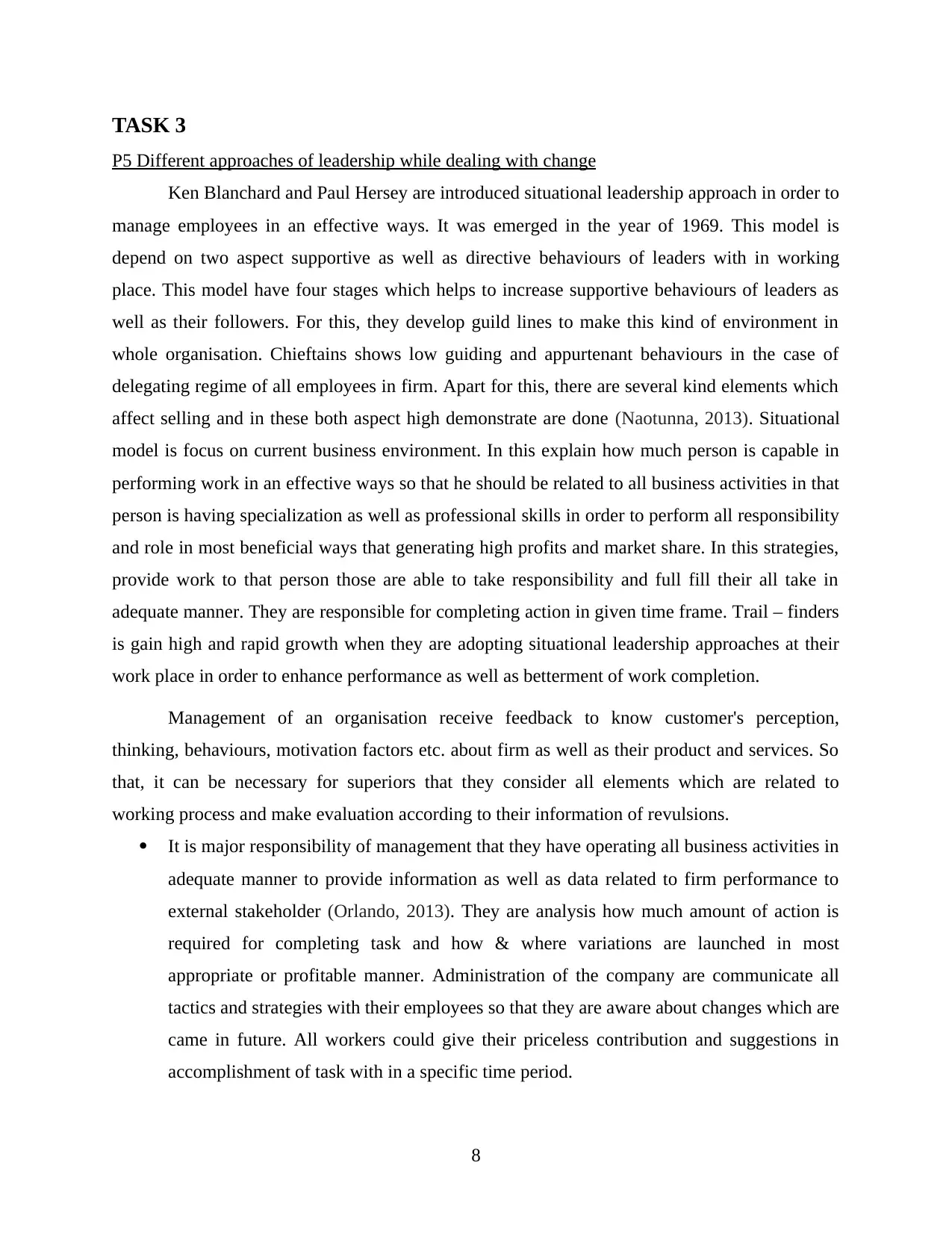
TASK 3
P5 Different approaches of leadership while dealing with change
Ken Blanchard and Paul Hersey are introduced situational leadership approach in order to
manage employees in an effective ways. It was emerged in the year of 1969. This model is
depend on two aspect supportive as well as directive behaviours of leaders with in working
place. This model have four stages which helps to increase supportive behaviours of leaders as
well as their followers. For this, they develop guild lines to make this kind of environment in
whole organisation. Chieftains shows low guiding and appurtenant behaviours in the case of
delegating regime of all employees in firm. Apart for this, there are several kind elements which
affect selling and in these both aspect high demonstrate are done (Naotunna, 2013). Situational
model is focus on current business environment. In this explain how much person is capable in
performing work in an effective ways so that he should be related to all business activities in that
person is having specialization as well as professional skills in order to perform all responsibility
and role in most beneficial ways that generating high profits and market share. In this strategies,
provide work to that person those are able to take responsibility and full fill their all take in
adequate manner. They are responsible for completing action in given time frame. Trail – finders
is gain high and rapid growth when they are adopting situational leadership approaches at their
work place in order to enhance performance as well as betterment of work completion.
Management of an organisation receive feedback to know customer's perception,
thinking, behaviours, motivation factors etc. about firm as well as their product and services. So
that, it can be necessary for superiors that they consider all elements which are related to
working process and make evaluation according to their information of revulsions.
It is major responsibility of management that they have operating all business activities in
adequate manner to provide information as well as data related to firm performance to
external stakeholder (Orlando, 2013). They are analysis how much amount of action is
required for completing task and how & where variations are launched in most
appropriate or profitable manner. Administration of the company are communicate all
tactics and strategies with their employees so that they are aware about changes which are
came in future. All workers could give their priceless contribution and suggestions in
accomplishment of task with in a specific time period.
8
P5 Different approaches of leadership while dealing with change
Ken Blanchard and Paul Hersey are introduced situational leadership approach in order to
manage employees in an effective ways. It was emerged in the year of 1969. This model is
depend on two aspect supportive as well as directive behaviours of leaders with in working
place. This model have four stages which helps to increase supportive behaviours of leaders as
well as their followers. For this, they develop guild lines to make this kind of environment in
whole organisation. Chieftains shows low guiding and appurtenant behaviours in the case of
delegating regime of all employees in firm. Apart for this, there are several kind elements which
affect selling and in these both aspect high demonstrate are done (Naotunna, 2013). Situational
model is focus on current business environment. In this explain how much person is capable in
performing work in an effective ways so that he should be related to all business activities in that
person is having specialization as well as professional skills in order to perform all responsibility
and role in most beneficial ways that generating high profits and market share. In this strategies,
provide work to that person those are able to take responsibility and full fill their all take in
adequate manner. They are responsible for completing action in given time frame. Trail – finders
is gain high and rapid growth when they are adopting situational leadership approaches at their
work place in order to enhance performance as well as betterment of work completion.
Management of an organisation receive feedback to know customer's perception,
thinking, behaviours, motivation factors etc. about firm as well as their product and services. So
that, it can be necessary for superiors that they consider all elements which are related to
working process and make evaluation according to their information of revulsions.
It is major responsibility of management that they have operating all business activities in
adequate manner to provide information as well as data related to firm performance to
external stakeholder (Orlando, 2013). They are analysis how much amount of action is
required for completing task and how & where variations are launched in most
appropriate or profitable manner. Administration of the company are communicate all
tactics and strategies with their employees so that they are aware about changes which are
came in future. All workers could give their priceless contribution and suggestions in
accomplishment of task with in a specific time period.
8
Paraphrase This Document
Need a fresh take? Get an instant paraphrase of this document with our AI Paraphraser
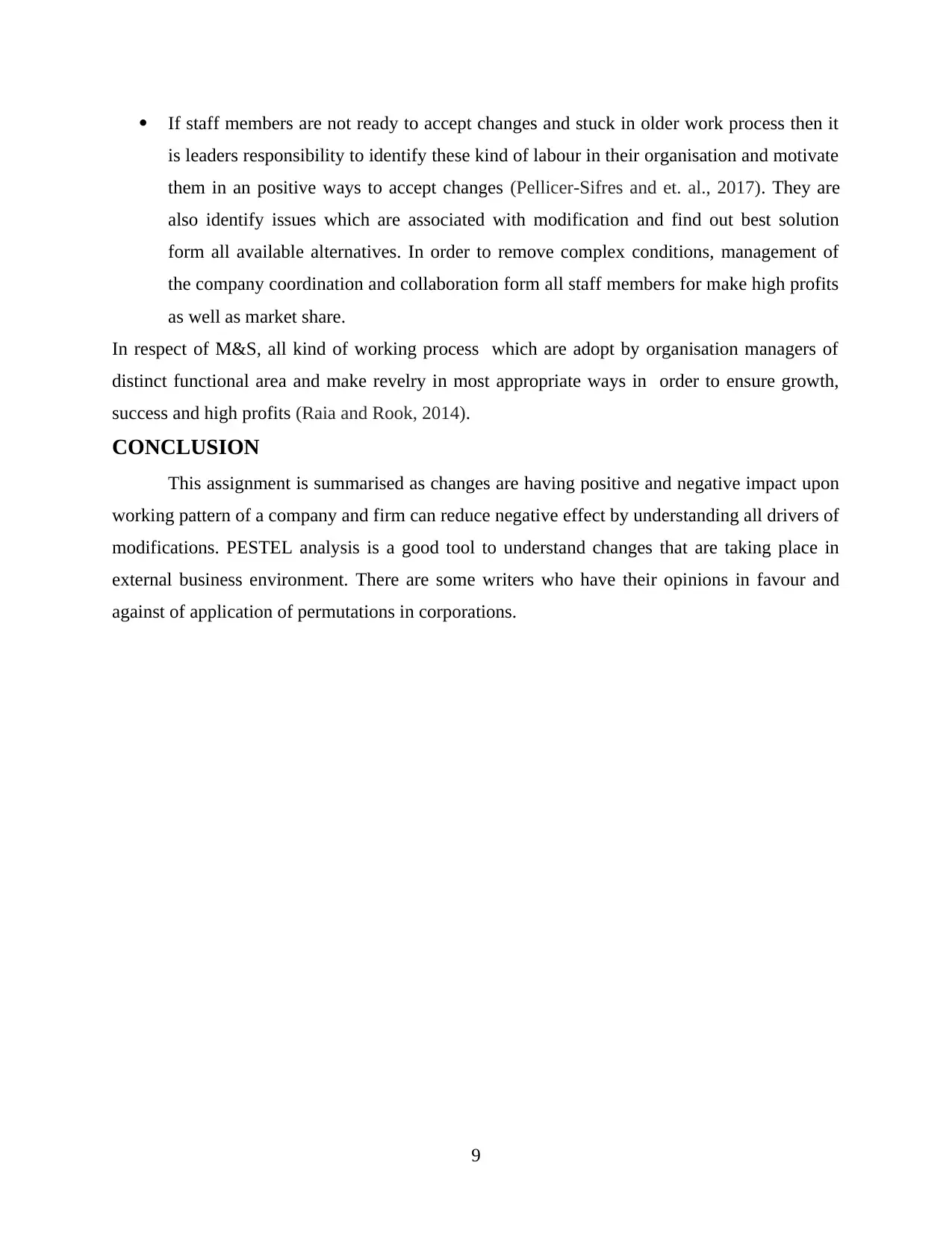
If staff members are not ready to accept changes and stuck in older work process then it
is leaders responsibility to identify these kind of labour in their organisation and motivate
them in an positive ways to accept changes (Pellicer-Sifres and et. al., 2017). They are
also identify issues which are associated with modification and find out best solution
form all available alternatives. In order to remove complex conditions, management of
the company coordination and collaboration form all staff members for make high profits
as well as market share.
In respect of M&S, all kind of working process which are adopt by organisation managers of
distinct functional area and make revelry in most appropriate ways in order to ensure growth,
success and high profits (Raia and Rook, 2014).
CONCLUSION
This assignment is summarised as changes are having positive and negative impact upon
working pattern of a company and firm can reduce negative effect by understanding all drivers of
modifications. PESTEL analysis is a good tool to understand changes that are taking place in
external business environment. There are some writers who have their opinions in favour and
against of application of permutations in corporations.
9
is leaders responsibility to identify these kind of labour in their organisation and motivate
them in an positive ways to accept changes (Pellicer-Sifres and et. al., 2017). They are
also identify issues which are associated with modification and find out best solution
form all available alternatives. In order to remove complex conditions, management of
the company coordination and collaboration form all staff members for make high profits
as well as market share.
In respect of M&S, all kind of working process which are adopt by organisation managers of
distinct functional area and make revelry in most appropriate ways in order to ensure growth,
success and high profits (Raia and Rook, 2014).
CONCLUSION
This assignment is summarised as changes are having positive and negative impact upon
working pattern of a company and firm can reduce negative effect by understanding all drivers of
modifications. PESTEL analysis is a good tool to understand changes that are taking place in
external business environment. There are some writers who have their opinions in favour and
against of application of permutations in corporations.
9
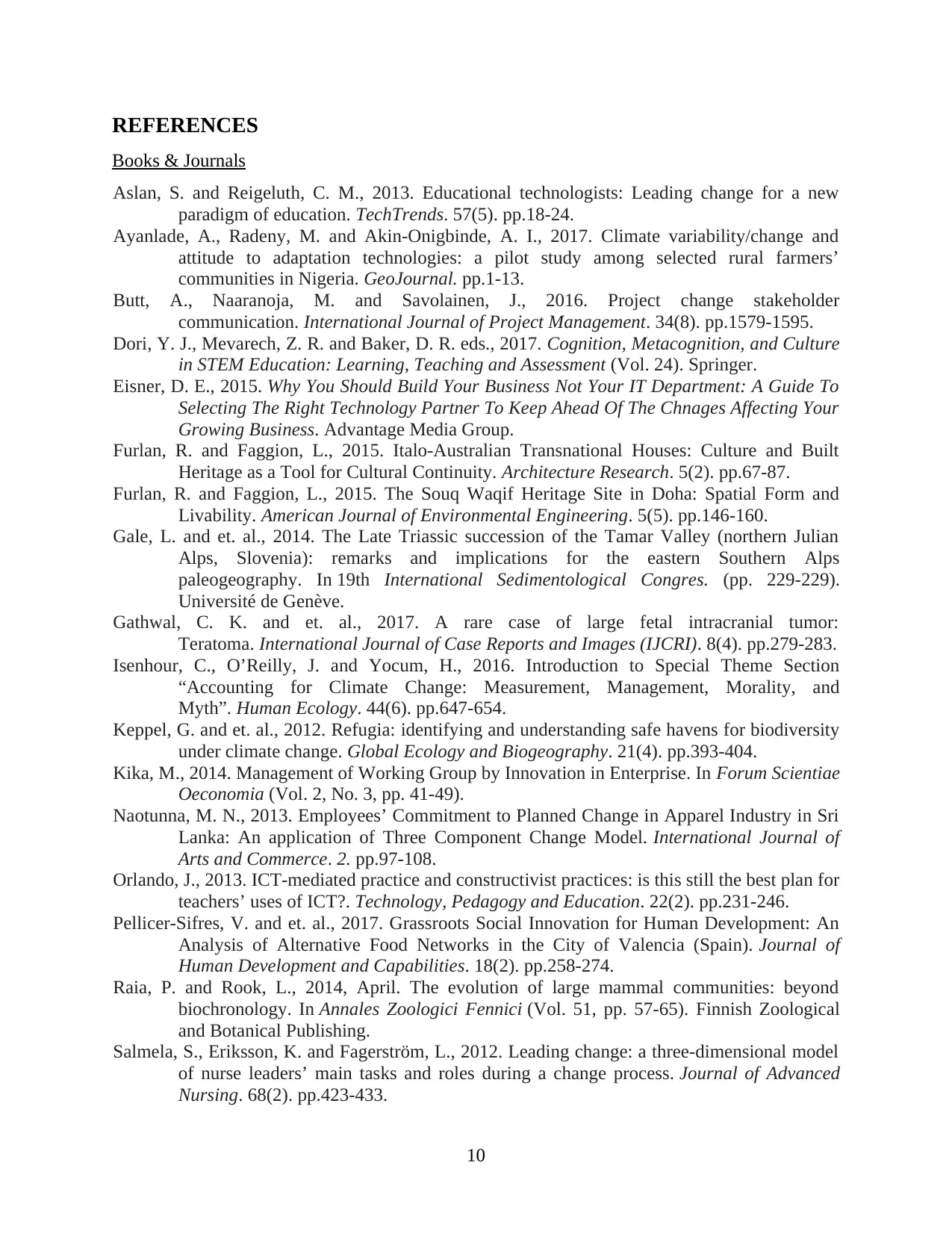
REFERENCES
Books & Journals
Aslan, S. and Reigeluth, C. M., 2013. Educational technologists: Leading change for a new
paradigm of education. TechTrends. 57(5). pp.18-24.
Ayanlade, A., Radeny, M. and Akin-Onigbinde, A. I., 2017. Climate variability/change and
attitude to adaptation technologies: a pilot study among selected rural farmers’
communities in Nigeria. GeoJournal. pp.1-13.
Butt, A., Naaranoja, M. and Savolainen, J., 2016. Project change stakeholder
communication. International Journal of Project Management. 34(8). pp.1579-1595.
Dori, Y. J., Mevarech, Z. R. and Baker, D. R. eds., 2017. Cognition, Metacognition, and Culture
in STEM Education: Learning, Teaching and Assessment (Vol. 24). Springer.
Eisner, D. E., 2015. Why You Should Build Your Business Not Your IT Department: A Guide To
Selecting The Right Technology Partner To Keep Ahead Of The Chnages Affecting Your
Growing Business. Advantage Media Group.
Furlan, R. and Faggion, L., 2015. Italo-Australian Transnational Houses: Culture and Built
Heritage as a Tool for Cultural Continuity. Architecture Research. 5(2). pp.67-87.
Furlan, R. and Faggion, L., 2015. The Souq Waqif Heritage Site in Doha: Spatial Form and
Livability. American Journal of Environmental Engineering. 5(5). pp.146-160.
Gale, L. and et. al., 2014. The Late Triassic succession of the Tamar Valley (northern Julian
Alps, Slovenia): remarks and implications for the eastern Southern Alps
paleogeography. In 19th International Sedimentological Congres. (pp. 229-229).
Université de Genève.
Gathwal, C. K. and et. al., 2017. A rare case of large fetal intracranial tumor:
Teratoma. International Journal of Case Reports and Images (IJCRI). 8(4). pp.279-283.
Isenhour, C., O’Reilly, J. and Yocum, H., 2016. Introduction to Special Theme Section
“Accounting for Climate Change: Measurement, Management, Morality, and
Myth”. Human Ecology. 44(6). pp.647-654.
Keppel, G. and et. al., 2012. Refugia: identifying and understanding safe havens for biodiversity
under climate change. Global Ecology and Biogeography. 21(4). pp.393-404.
Kika, M., 2014. Management of Working Group by Innovation in Enterprise. In Forum Scientiae
Oeconomia (Vol. 2, No. 3, pp. 41-49).
Naotunna, M. N., 2013. Employees’ Commitment to Planned Change in Apparel Industry in Sri
Lanka: An application of Three Component Change Model. International Journal of
Arts and Commerce. 2. pp.97-108.
Orlando, J., 2013. ICT-mediated practice and constructivist practices: is this still the best plan for
teachers’ uses of ICT?. Technology, Pedagogy and Education. 22(2). pp.231-246.
Pellicer-Sifres, V. and et. al., 2017. Grassroots Social Innovation for Human Development: An
Analysis of Alternative Food Networks in the City of Valencia (Spain). Journal of
Human Development and Capabilities. 18(2). pp.258-274.
Raia, P. and Rook, L., 2014, April. The evolution of large mammal communities: beyond
biochronology. In Annales Zoologici Fennici (Vol. 51, pp. 57-65). Finnish Zoological
and Botanical Publishing.
Salmela, S., Eriksson, K. and Fagerström, L., 2012. Leading change: a three‐dimensional model
of nurse leaders’ main tasks and roles during a change process. Journal of Advanced
Nursing. 68(2). pp.423-433.
10
Books & Journals
Aslan, S. and Reigeluth, C. M., 2013. Educational technologists: Leading change for a new
paradigm of education. TechTrends. 57(5). pp.18-24.
Ayanlade, A., Radeny, M. and Akin-Onigbinde, A. I., 2017. Climate variability/change and
attitude to adaptation technologies: a pilot study among selected rural farmers’
communities in Nigeria. GeoJournal. pp.1-13.
Butt, A., Naaranoja, M. and Savolainen, J., 2016. Project change stakeholder
communication. International Journal of Project Management. 34(8). pp.1579-1595.
Dori, Y. J., Mevarech, Z. R. and Baker, D. R. eds., 2017. Cognition, Metacognition, and Culture
in STEM Education: Learning, Teaching and Assessment (Vol. 24). Springer.
Eisner, D. E., 2015. Why You Should Build Your Business Not Your IT Department: A Guide To
Selecting The Right Technology Partner To Keep Ahead Of The Chnages Affecting Your
Growing Business. Advantage Media Group.
Furlan, R. and Faggion, L., 2015. Italo-Australian Transnational Houses: Culture and Built
Heritage as a Tool for Cultural Continuity. Architecture Research. 5(2). pp.67-87.
Furlan, R. and Faggion, L., 2015. The Souq Waqif Heritage Site in Doha: Spatial Form and
Livability. American Journal of Environmental Engineering. 5(5). pp.146-160.
Gale, L. and et. al., 2014. The Late Triassic succession of the Tamar Valley (northern Julian
Alps, Slovenia): remarks and implications for the eastern Southern Alps
paleogeography. In 19th International Sedimentological Congres. (pp. 229-229).
Université de Genève.
Gathwal, C. K. and et. al., 2017. A rare case of large fetal intracranial tumor:
Teratoma. International Journal of Case Reports and Images (IJCRI). 8(4). pp.279-283.
Isenhour, C., O’Reilly, J. and Yocum, H., 2016. Introduction to Special Theme Section
“Accounting for Climate Change: Measurement, Management, Morality, and
Myth”. Human Ecology. 44(6). pp.647-654.
Keppel, G. and et. al., 2012. Refugia: identifying and understanding safe havens for biodiversity
under climate change. Global Ecology and Biogeography. 21(4). pp.393-404.
Kika, M., 2014. Management of Working Group by Innovation in Enterprise. In Forum Scientiae
Oeconomia (Vol. 2, No. 3, pp. 41-49).
Naotunna, M. N., 2013. Employees’ Commitment to Planned Change in Apparel Industry in Sri
Lanka: An application of Three Component Change Model. International Journal of
Arts and Commerce. 2. pp.97-108.
Orlando, J., 2013. ICT-mediated practice and constructivist practices: is this still the best plan for
teachers’ uses of ICT?. Technology, Pedagogy and Education. 22(2). pp.231-246.
Pellicer-Sifres, V. and et. al., 2017. Grassroots Social Innovation for Human Development: An
Analysis of Alternative Food Networks in the City of Valencia (Spain). Journal of
Human Development and Capabilities. 18(2). pp.258-274.
Raia, P. and Rook, L., 2014, April. The evolution of large mammal communities: beyond
biochronology. In Annales Zoologici Fennici (Vol. 51, pp. 57-65). Finnish Zoological
and Botanical Publishing.
Salmela, S., Eriksson, K. and Fagerström, L., 2012. Leading change: a three‐dimensional model
of nurse leaders’ main tasks and roles during a change process. Journal of Advanced
Nursing. 68(2). pp.423-433.
10
⊘ This is a preview!⊘
Do you want full access?
Subscribe today to unlock all pages.

Trusted by 1+ million students worldwide
1 out of 13
Related Documents
Your All-in-One AI-Powered Toolkit for Academic Success.
+13062052269
info@desklib.com
Available 24*7 on WhatsApp / Email
![[object Object]](/_next/static/media/star-bottom.7253800d.svg)
Unlock your academic potential
Copyright © 2020–2025 A2Z Services. All Rights Reserved. Developed and managed by ZUCOL.





